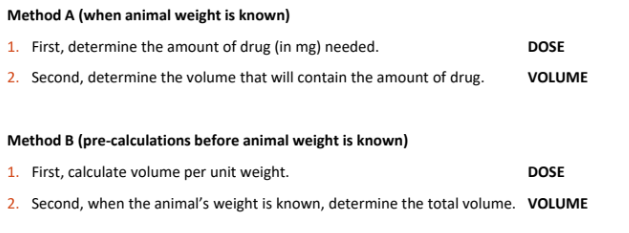Chemical Immobilization
Objectives
types of drugs
important considerations: dosing, conditions, monitoring anesthesia
Practice: IV, IM, Blood draw
Human and animal safety are the number one priority
General information
no certification
many drugs are Schedule II or III. They’re controlled by the DEA, disbursed by a veterinarian, and closely regulated
In some circumstances, a vet must be on hand to administer drugs
meat withdrawl
Drug Terminology
Anesthesia- lack of consciousness, unresponsive, affects CNS
Tranquilizer- calming effect. does not make unresponsive. often used in conjunction with dissociatives
Sedative- depresses CNS, causes uncoordination and/or a sleep-like state. stronger than tranquilizers, overdose can cause cardiac or respiratory depression
Antagonist- antidote
Dissociative Anesthetics
Ketamine and tiletamine (telazol)
Produces a tense anesthesia- muscle tension
seizures possible
strong heart rate and breathing
salivation
hypersensitivity
no antagonist
Sedatives
xylazine and medetomidine
depresses CNS- many reflexes absent, depresses heart rate and respiration
usually used with ketamine
bloat, vomiting, hypotension possible
animals can be roused, but will return to sleep-like state
“drunk”
can be antagonized
Tranquilizers
Azaperone and Zolazepam
does not affect CNS
creates calming effect, but animal is not unresponsive
responds to pain, noise, fear.
unused in combination with opioids and dissociatives to combat side effects
possible antagonists
Opioids
M99 and carfentanil
narcotics
many simulate an anesthetic
can be lethal
may be responive to external stimuli
can be antagonized
Administration
sold as powder or concentrate
mix appropriate dose
select appropriate delivery method
Consider order of procedures
perform painful procedures at the peak of anesthesia
be prepared to euthanize
Considerations:
Mass x Velocity²
Too much velocity- bounce out
Use laser range finder to determine how far away animal is
PRACTICE
Factors influence response
weight, sex, age, seasons, idiosyncrasies, temperament, drug tolerance, food, pathological conditions
Calculating doses
need to know: recommended dose, concentration, and weight of animal

dose x weight of animal x concentration = mg of drug delivered
dose x concentration= volume of drug drawn in mL
dose x weight of animal = mg of drug needed
Animal Handling
Basic care
ground cloth- untreated canvas
body position- Sternal or lateral (for cold animals)
Eye hood, ointment, noise control
ALL animals benefit from head cover
apply Opthalmic ointment in warm temps, and never with steroids
QUIET
Bears- cover eyes before leaving
Monitor: TPR, temperature, pulse, respiration, capillary refill, gum color, use pulse oximeter
Processing procedures
weight
mark- ear tag, tattoo, radio collar, implants, or PIT tag
blood collection
teeth
Emergencies
hypo or hyperthermia
shock
bloat
inhaling stomach contents
seizures
capture myopathy
injuries